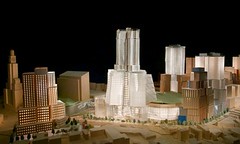Atlantic Yards Brooklyn, a big project falling down?

Atlantic Yards rendering.
The crunch in the real estate market brings some hope to some of us, those who have been working against certain ill-conceived big projects requiring massive public subsidies, land, condemnation, and/or displacement.
Earlier this week, a goodly number of the architects designing the Atlantic Yards project under the direction of Frank Gehry were laid off. See "Architect drops ax on Yards staff" from the New York Daily News, which was first reported in the Wall Street Journal, "Gehry Lays Off Staff."
These articles are interesting as well:
-- Atlantic Yards at 5: What went wrong? from the Brooklyn Paper
-- Trouble spot: Nets' attendance should be on the NBA's (and Times's) radar from the Atlantic Yards Report blog
I expect that the lead "developers" of the Florida Market will eventually fade away as well. They brought to the table political connections (Mayor Williams, Councilmember Vincent Orange and his successors) willing to use the power and authority of government to privilege their position and take property directly (eminent domain) or indirectly (through fear of takings, people end up acceding/giving in).
Cheap money enables bad projects.
When money isn't cheap anymore, quality matters, and bad deals fade away if they haven't already broken ground...
From "It Was Fun Till the Money Ran Out," in today's New York Times:
Firms like Forest City Ratner and the Related Companies, which once worked exclusively with corporations that were more adept at handling big budgets than at architectural innovation, seized on these innovators as part of a shrewd business strategy. The architect’s prestige would not only win over discerning consumers but also persuade planning boards to accede to large-scale urban projects like, say, Mr. Gehry’s Atlantic Yards in Brooklyn.
But somewhere along the way that fantasy took a wrong turn. As commissions multiplied for luxury residential high-rises, high-end boutiques and corporate offices in cities like London, Tokyo and Dubai, more socially conscious projects rarely materialized. Public housing, a staple of 20th-century Modernism, was nowhere on the agenda. Nor were schools, hospitals or public infrastructure. Serious architecture was beginning to look like a service for the rich, like private jets and spa treatments.
We saw this in DC a bunch, with Mr. Gehry and a proposed expansion of the Corcoran Gallery of Art, and a number of projects allegedly involving Sir Norman Foster, who did do the enclosed courtyard project for the Smithsonian American Art Museum and National Portrait Gallery.
Even though I am not a fan of starchitecture, I have to admit that most of my opposition to it doesn't have to do as much with the "quality of the architecture" -- the design -- as much as it has to do with the "program of the building" or the way that the building is designed to accomplish its purpose as well as how it connects to the street and the area beyond the confines of the lot, and how it strengthens and extends the quality of place and urban design.
In some respects, I think as long as you get the first 2-4 floors of a building right on the outside, and of course, how the building works inside, design doesn't matter much.
I will agree that my own preference and this is, I admit, a matter of aesthetics, is for architecture that fits in (but not always) rather than screams and is disconnected.
See "The audacity of hope for better public works" from the Boston Globe. From the article:
Last Saturday, President-elect Obama announced plans for a "public works construction program" that will be "the largest new investment in our national infrastructure since the creation of the federal highway system in the 1950s."
Is he talking about architecture? I'm not getting my hopes up. Obama is a lawyer, and lawyers usually think more about social and economic issues than about the physical world we build and inhabit. In his radio announcement, Obama mentioned roads and bridges, sewer systems, schools, mass transit, electrical grids, dams and other public utilities, windmills and solar panels, and expanded access to the Internet. Nothing in there specifically about architecture.
My response is that nothing in there is specifically about "urban design" and the broader context of the built environment. That's key. Not just spending money, in a stimulus plan specifically or generally in how municipalities, states, and the federal government design and fund buildings and projects.
Labels: Growth Machine, real estate development, sports and economic development, urban design/placemaking



0 Comments:
Post a Comment
<< Home